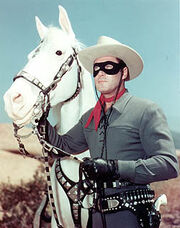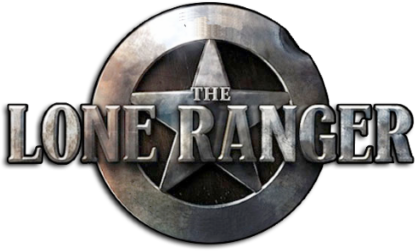m (fixing dead links) |
(added Jay Thomas story) Tag: Visual edit |
||
| Line 24: | Line 24: | ||
In keeping with the nature of the Ranger character, Moore chose to protect the Ranger's identity at all times and is perhaps the only actor whose full face is largely unknown to the public. It was never shown in the TV series, although occasionally he would don a disguise and affect an accent, revealing the upper half of his face in the process. However, there is no shortage of photos of Moore unmasked, including many in his autobiography. His many fans, however, could easily recognize him by his distinctive voice. |
In keeping with the nature of the Ranger character, Moore chose to protect the Ranger's identity at all times and is perhaps the only actor whose full face is largely unknown to the public. It was never shown in the TV series, although occasionally he would don a disguise and affect an accent, revealing the upper half of his face in the process. However, there is no shortage of photos of Moore unmasked, including many in his autobiography. His many fans, however, could easily recognize him by his distinctive voice. |
||
| + | |||
| + | ==The Jay Thomas Story== |
||
| + | Beginning in 1998, actor and radio personality Jay Thomas made annual Christmas visits to David Letterman on his late night TV show. In each appearance Thomas related his story from his days as a disc jockey for a radio station in Charlotte, North Carolina. During that time he and a colleague made a promotional appearance at a car dealership where Clayton Moore, dressed as the Lone Ranger, also appeared. |
||
| + | |||
| + | As the story goes, after the broadcast ended Thomas and his friend (who were dressed in the wild garb of the day) went off to secretly smoke a marijuana joint behind a dumpster. When they returned to pack up their equipment, they discovered that Moore was still there, as the car that was supposed to drive him back to the hotel where he stayed never arrived, so Thomas offered Moore a ride in his own car, which Moore accepted. While in traffic, with Moore sitting silently in the back seat, an impatient middle-aged man backed his Buick into the front end of Thomas' car, broke a headlight, and then drove off with an angry Thomas chasing the Buick through heavy traffic. When he finally caught up to the man, and confronted him about the damage the indignant driver denied all. Then when Thomas threatened to call the police, the man claimed no one would believe his story because Thomas and his friend looked like "two hippie freaks". At that moment, Moore, still in costume, got out of the car and said to the man, "They'll believe '''me''', citizen!" |
||
| + | |||
| + | For every year thereafter, with the exception of 2013, Thomas appeared every Christmas on Letterman's show to re-tell the story; his final appearance and his telling of the story was in 2014, shortly before Letterman retired the following May. Jay Thomas died of throat cancer in August 2017. |
||
==Death== |
==Death== |
||
Revision as of 05:41, 22 January 2018
This article contains information from Wikipedia

Clayton Moore as The Lone Ranger
Clayton Moore (September 14, 1914 – December 28, 1999) was an American actor best known for playing the fictional western character The Lone Ranger.
Early years
Born as Jack Carlton Moore in Chicago, Illinois, Moore was a circus acrobat as a boy, then later enjoyed a successful career as a John Robert Powers model. Moving to Hollywood in the late 1930s, he began working as a stunt man and bit player between modeling jobs. According to his autobiography, around 1940 Hollywood producer Edward Small persuaded him to adopt the stage name "Clayton" Moore. He was an occasional player in B westerns and Republic Studio cliffhangers, ultimately starring in more such films than serial hero Buster Crabbe.
Moore served in the U.S. Army Air Forces during World War II and made training films (Target--Invisible, etc.) with the First Motion Picture Unit.
As The Lone Ranger
Moore's big break came in 1949, when George W. Trendle spotted him in Ghost of Zorro. As producer of the radio show and creator of "The Lone Ranger" character, with writer Fran Striker, Trendle was about to launch the masked man in the new medium of television. Moore was cast on sight.
Moore then faced the challenge of training his voice to sound like the radio version of The Lone Ranger, which had then been on the air since 1933, and succeeded in lowering his already distinctive baritone even further. With the first notes of Rossini's stirring "William Tell Overture" and announcer Fred Foy's "Return with us now, to those thrilling days of yesteryear ... ," Moore and co-star Jay Silverheels, in the role of Tonto, made television history as the first Western written specifically for that medium. The Lone Ranger soon became the highest-rated program to that point on the fledgling ABC network and its first true "hit," earning an Emmy nomination in 1950.
Leaving series
After two successful years, which presented a new episode every week, 52 weeks a year, Moore had a pay dispute and left the series. As "Clay Moore," he made a few more westerns and serials, sometimes playing the villain. The public did not accept the new Lone Ranger, actor John Hart; so the owners of the program relented and rehired Moore at his requested salary. He stayed with the program until it ended first-run production in 1957. He and Jay Silverheels also starred in two feature-length "Lone Ranger" motion pictures. Moore appeared in other series too, including a role in the 1952 episde "Snake River Trapper" of Bill Williams' syndicated western, The Adventures of Kit Carson.
After completion of the second feature, The Lone Ranger and the Lost City of Gold in 1958, Moore embarked on what eventually became 40 years of personal appearances, TV guest spots, and classic commercials as the legendary masked man. Silverheels joined him for occasional appearances during the early 1960s, and throughout his career Moore always expressed his tremendous respect and love for Silverheels.
Lawsuit over public appearances
In 1979, the owner of the Ranger character, Jack Wrather, obtained a court order prohibiting Moore from making future appearances as The Lone Ranger. Wrather anticipated making a new film version of the story, and did not want the value of the character being undercut by Moore's appearances, nor anyone to think that the 65-year-old Moore would be playing the role in the new picture. This move proved to be a public relations disaster of the first order. Moore responded by changing his costume slightly and replacing the mask with similar-looking wraparound sunglasses, and then counter-sued Wrather. He eventually won the suit, and was able to resume his appearances in costume, which he continued to do until shortly before his death. For a time he worked in publicity tie-ins with the Texas Rangers baseball team. (Wrather's planned motion picture remake, The Legend of the Lone Ranger, was released in 1981 and was a critical and commercial failure.)
Moore often was quoted as saying he had "fallen in love with the Lone Ranger character" and strove in his personal life to take The Lone Ranger Creed to heart. This, coupled with his public fight to retain the right to wear the mask, ultimately elevated him in the public's eyes to an American folk icon. In this regard, he was much like another cowboy star, William Boyd, who nurtured the Hopalong Cassidy character. Moore was so identified with the masked man that he is the only person on the Hollywood Walk of Fame to have his character's name along with his on the star, which reads, "Clayton Moore — The Lone Ranger." He was inducted into the Stuntman's Hall of Fame in 1982 and in 1990 was inducted into the Western Performers Hall of Fame at the National Cowboy & Western Heritage Museum in Oklahoma City, Oklahoma.
In keeping with the nature of the Ranger character, Moore chose to protect the Ranger's identity at all times and is perhaps the only actor whose full face is largely unknown to the public. It was never shown in the TV series, although occasionally he would don a disguise and affect an accent, revealing the upper half of his face in the process. However, there is no shortage of photos of Moore unmasked, including many in his autobiography. His many fans, however, could easily recognize him by his distinctive voice.
The Jay Thomas Story
Beginning in 1998, actor and radio personality Jay Thomas made annual Christmas visits to David Letterman on his late night TV show. In each appearance Thomas related his story from his days as a disc jockey for a radio station in Charlotte, North Carolina. During that time he and a colleague made a promotional appearance at a car dealership where Clayton Moore, dressed as the Lone Ranger, also appeared.
As the story goes, after the broadcast ended Thomas and his friend (who were dressed in the wild garb of the day) went off to secretly smoke a marijuana joint behind a dumpster. When they returned to pack up their equipment, they discovered that Moore was still there, as the car that was supposed to drive him back to the hotel where he stayed never arrived, so Thomas offered Moore a ride in his own car, which Moore accepted. While in traffic, with Moore sitting silently in the back seat, an impatient middle-aged man backed his Buick into the front end of Thomas' car, broke a headlight, and then drove off with an angry Thomas chasing the Buick through heavy traffic. When he finally caught up to the man, and confronted him about the damage the indignant driver denied all. Then when Thomas threatened to call the police, the man claimed no one would believe his story because Thomas and his friend looked like "two hippie freaks". At that moment, Moore, still in costume, got out of the car and said to the man, "They'll believe me, citizen!"
For every year thereafter, with the exception of 2013, Thomas appeared every Christmas on Letterman's show to re-tell the story; his final appearance and his telling of the story was in 2014, shortly before Letterman retired the following May. Jay Thomas died of throat cancer in August 2017.
Death
Clayton Moore died on December 28, 1999, in a West Hills, California, hospital after suffering a heart attack at his home in nearby Calabasas, California. He was buried at Forest Lawn Memorial Park in Glendale, California.
Autobiography
I Was That Masked Man, by Clayton Moore with Frank Thompson, Taylor Publishing Company, 1996 - ISBN 0-87833-939-6
